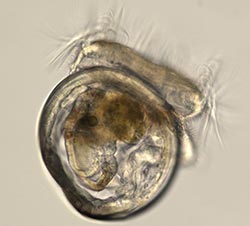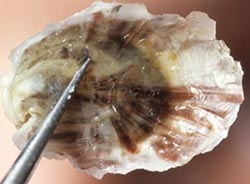Seed Providers


Instate Hatcheries and Seed Distribution Facilities
To distribute shellfish seed to a permitted aquatic farm, nursery, hatchery within Alaska or for export, an instate facility is required to obtain a valid seed source approval issued by ADF&G. An acceptable disease history specific for the facility site and the shellfish stock is required prior to allowing stock to be transported. Once issued, these approvals are valid for one to three years, depending on the disease history of the permitted facility site.
Approval Requirements:
- An acceptable disease history for the shellfish stock to be transported from the facility.
- If no disease history is on record with the department, then at least 30 live animals from the cohort proposed for transport must be submitted to the ADF&G Fish Pathology Laboratory for histological examination at least 60 days prior to issuance of a shellfish transport permit. Follow the procedures for shipment of shellfish for pathology examination Anchorage (PDF 14 kB) and Juneau (PDF 14 kB) and include the Pathology Examination Sample Submission Form (PDF 14 kB) with the samples. The department provides a written disease report regarding submitted samples within 120 days after receipt of the seedstock.
- Approvals are issued upon an acceptable disease history and are valid from one to three years depending on the disease history.
Requirements for export of live shellfish outside Alaska
- An approved shellfish transport permit is required.
- Authorization from receiving state authorities is required prior to issuance of an approved ADF&G transport permit.
Out-Of-State Hatcheries and Seed Distribution Facilities for Shellfish Importation Certification
To import shellfish seed to a permitted aquatic farm, nursery, hatchery into the state, an out-of-state facility is required to obtain a valid seed source certificate issued by ADF&G. More extensive pathology examinations are required for out-of state facilities in order to minimize the risk of exotic pathogens of concern entering into Alaska. The certifications are facility site and stock specific. Certifications are generally valid for one year from the date of sample collection for pathology examinations.
Live oysters can only be imported for aquaculture purposes into Alaska if the broodstock is derived from oysters commercially cultured on the Pacific coast of North America through three or more generations and disease history or inspection indicates no incidence of disease that is not indigenous to the state or that are not considered a risk to indigenous stocks, and oyster health and marketability (5 ACC 41.070).
To apply, provide a letter on facility letterhead with contact information requesting to be certified to import Pacific oysters into Alaska and attach all the materials needed to meet the certification requirements. The required documents can all be sent together to general aquatic farming email: dfg.dcf.aquaticfarming@alaska.gov to begin the review process. If the documents are too large to send in one email, please consider zipping the documents or sending them using ZendTo at https://drop.state.ak.us/drop/.
Certification Requirements:
- Live samples for histological examination and Polymerase chain reaction (PCR) for specific pathogens submitted to Aqua Technics, Inc. or other Animal and Plant Health Inspection Service (APHIS) approved laboratory. Samples required are:
- 60 live adult animals from the parent broodstock,
- 60 live spat from the cohort of animals proposed for transport,
- 1,000 larvae (if applicable)
- Disease history information.
- An operating plan and schematic layout for the facility.
- No detection of disease or pathogens in any of the shellfish stocks present at the facility.
- Separate broodstocks are from the same sources and locations from year to year.
- Broodstock and seedstock must be physically or geographically isolated from non-certified stocks through all stages of culture.
- Certification is generally valid for one year with a few exceptions allowed with conditions.
Certification Renewal Requirements:
- Histological examination of 60 live spat and 1,000 larvae (if applicable) from the year class to be transported
- An updated broodstock disease history
- A statement of the hatchery performance reviewing success, problems, and mortality during the previous growing season.
Pathology Examination Sample Submission Form (PDF 14 kB).
For more details on the ADF&G certification requirements for shellfish refer to Page 11�14 of Regional Information Report 5J14-04, Policies and Guidelines for Alaska Fish and Shellfish Health and Disease Control (PDF 614 kB), by Dr. Ted Meyers. October 2014. 55 pp.
